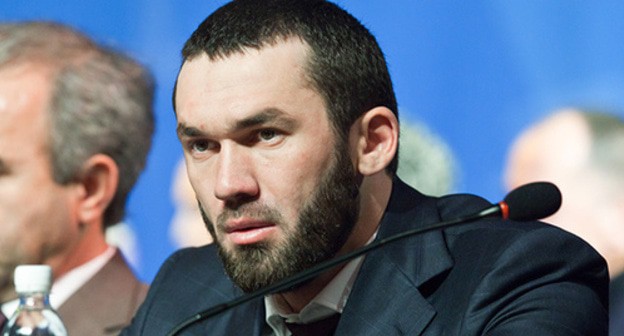Beliefs of the Nogais
Most of the Nogais are Moslems-sunnites of hanafit kind. Most likely Islam started to penetrate the territory of Nogai`s ancestors (nomadic Turks) since the 10-11 centuries. Their mass Islamisation started in the Golden Horde when Khan Uzbek implemented Moslem religion officially in 1312.
Folk stories of the Nogais connect their taking of Islam with the Golden Horde ( Nogais are associated with the ?uzbeks) and with the ?sultan Babatkul. Sultan Babatkul is the ?holy? Baba Tukles, or Baba-Tukles Shashlu-Aziz, well known among Kazakhs, Karakalpaks, Uzbeks and Nogais. The rulers of Nogai Horde, the successors of the Golden Horde beklyaribek Yedigei, considered this ?saint and one of the four ?righteous caliphs their ancestors. Thus the folk stories illustrated a great role of the sufi sheikhs in making Islam strong in the spacious steppes of Eurasia that were once the motherland of most Nogai tribes.
By the time of ethnic consolidation (15th century) Islam was strong among the Nogais and greatly influenced their culture. The heritage of the pagan times survived behind the Islam surface. Thus the synonym of the word ?Allah? is the name of the ancient Turk supreme god - Tangir. Till nowadays there survived the beliefs in the spirits-owners of the elements: ground, water, wind etc. Islam brought the image of the spirit genie. The healing practice of the mullahs and healers is based on the belief in these spirits. Some ancient beliefs of the Nogais disappear and become folklore: demon albasli, dragon azdaa, spirits Sazagan, Yelmaviz, pari, obir etc.
Judging by the information we have it may be concluded that in the Middle Ages Islam existed among the Nogais in the form of sufizm that better suited their Nomadic life and their psychology. The doctrine of the brotherhood Jasavia was spread among the Nogais of the Big Nogai Horde, the other groups of Nogais followed the teaching Nakshbandia. As late as the last century Kazakhs-adayevs were telling stories about the famous Nogai shaikh Heirulla-Sufuye that lived at the Mangishlak at the times of the Nogai Horde and was worshipped as a great miracle-worker. His silsila was traced through the ?saints? Sultan Epe (Sultan-apa) and Gakim-Ata (Khakim-ata) to the khvaja Akhmad al-Jasavi. Having lost the political independence and survived the tragedy of forced resettlement (mukhajara), Nogais lost their own sufi traditions and in the 19-20th centuries Islam mysticism wasn`t common among them and was not of a local origin (from Buchara, Dagestan and Chechnya).
One of the typical features of Nogais at the time of the Nogai Horde was their respectful attitude to the tombs (kishene/keshene) of their important people, mainly the rulers. Over the burial place of the noble or ?holy? person they constructed architectural monuments. Since that time in the North Caucasus there survived the Tatartup minaret and the mausoleum Borga Kash built at the time of the golden Horde and attributed to the Nogai tribe borgans. Nogais had mosques of two kinds: stationary roofed and ?opened?. Stationary mosques were built in the places of winter settlements and in the settled villages. Nomadic Nogais prayed in a special tent in winter time, and during the warm part of the year they made an ?open? mosque in the steppe: there was cleaned a space big enough to take all the members of the society and the common prayer was performed there. Such places for praying were usually made before the Friday prayer; after moving they cleaned a new place. Nogais are known for their liking to perform prayers in the open air. The ?holy places? are usually the tombs of the people known for their righteous life; they are marked with a pole with multi-colored rags. The major part of Nogais doesn?t visit them, the cult of the ?holy? places remained only among the part of the Astrakhan Nogais.
The years of Soviet power brought great harm to the religious life of the Nogais. During the 1920-1930-ies all the mosques were destroyed, they persecuted the majority of the mullahs, kadis (shariat judges), efendi (people with higher religious education), akhuns, imams, muezzins. Those that survived had to stop their activities. By the beginning of 1990-ies there were no more than 2-3 mullahs left on the territory of the Nogai steppe that knew Arab literacy. Only a small number of older people performed the namaz (Moslem prayer 5 times a day). As there were no mosques, namaz was performed individually, and there was no religious education at all, not even at homes. At the same time Nogais were trying to preserve the outward indications of belonging to Islam: they didn?t eat pork, performed circumcision etc.).
In the past religious literature was common among the Nogais. These were different editions and the copies of Koran, tafsirs and other books. There were many books on the religious doctrine of hanafit mazkhab ("Dror", "Multana" etc.). Nogai efendi and mullahs had good collections of religious literature in Arab, Nogai and other Turk languages. Among the literate part of the Nogai society there were also popular the periodicals published in Russia and abroad: Nogai newspaper "Edil"' that was published by the Astrakhan Abdurakhman (`Abd ar-Rakhman) Umerov, Russian newspapers in Turk "Vakit", "Yulduz", "Ulfat", "Tarjuman", Turkish - "Mizan", "Savakh" etc. During the Soviet years most of the book collections perished; modern private and mosque collections are what was saved at that time. There are many manuscripts in those collections.
In the last years religious life revived on the Nogai territory. Mosques are built, there appear imams and muezzins (if the mosque is small, both duties are performed by the same person). Religious rituals are performed. They celebrate mavlid - the birthday of the prophet and the two main Moslem holidays - Uraza-bairam and Kurban-bairam. At the mosques they open mektebs (no more than 10) where they teach initial information about Islam. Madrasa are opened at the big mosques. There they teach the basics of the Arab language, religion (din) and cult (ibadet). Nogais get further religious education in Islam higher educational establishments of Bukhara, Ufa, Cherkessk, Buinaksk and other cities as well as abroad. Dozens of young Nogais study in Islam higher educational establishmants of Egypt, Kuwait, Saudi Arabia, Turkey and Iran, icluding the well - known al - Azkhar in Cairo.
Since the beginning of 1990-ies Nogais actively restore the wide connections with the outer Moslem world that were typical for them before the revolution of 1917. After a 70-year interval in the Nogai steppe there appeared their own haji, and their number is growing. They get connected with the Nogai diaspora, mainly in Turkey.
Nowadays the steppe Nogais are surrounded by the shafiit population nearly on all the sides, and it shows. In the place of especially close neighborhood (Babayurt district of Dagestan, Shelkovskoi district of Chechnya) part of the Nogai population adopted the shafiit kind of Islam. At the same time the religious authorities, considering the hanafit kind to be part of the ethnic origin of Nogais, actively struggle against shafiizm penetrating the young people. Mullahs have to struggle against the ideas of vakhabizm that penetrate from the territory of Dagestan and Chechnya in the last 5-6 years. Vakhabizm is mostly spread especially among the young Nogais on the territory of Shelkovskoi district of Chechnya, but there were no riots between the vakhabits and hanafits. Islam parties or movements didn?t get popular among the Nogais.
The danger of losing the confessional part of ethnic self-consciousness makes Nogais to look for an exit from this situation. Religious authorities suggest to form the kadiat of the Nogai steppe similar to the Nogai kadiat that existed in the 19th - beginning of the 20th century. The congress of the Moslems of Nogai steppe in 1990 elected imam Kozhayev Ya.A. the Kadi of Nogai steppe, but kadiat wasn?t formed then. In fact most of the Nogai societies keep their autonomy; part of them are subject to the relevant territorial muftiats (muftijats) - Ecclesiastical management of Moslems of Karachaevo-Cherkesia and Stavropol territory, Ecclesiastical management of Moslems of Dagestan, Ecclesiastical management of Moslems of the Chechen Republic Ichkeria. In the Dagestan republic there also exists Ecclesiastical management of Moslems of Nogai district that tries to unite all the societies of the Nogai steppe.




![Tumso Abdurakhmanov. Screenshot from video posted by Abu-Saddam Shishani [LIVE] http://www.youtube.com/watch?v=mIR3s7AB0Uw Tumso Abdurakhmanov. Screenshot from video posted by Abu-Saddam Shishani [LIVE] http://www.youtube.com/watch?v=mIR3s7AB0Uw](/system/uploads/article_image/image/0001/18460/main_image_Tumso.jpg)